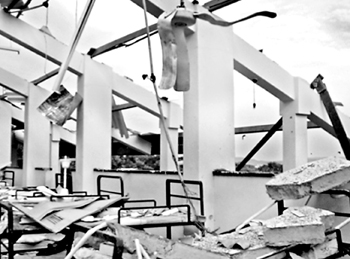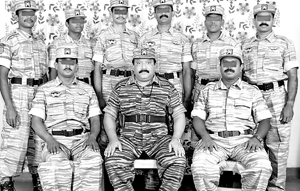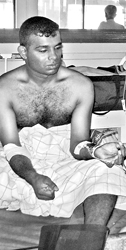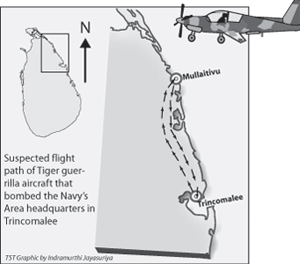| Columns - Situation report |
|
| The grave story of the "ghost" aircraft |
- LTTE air wing's first strike for 2008 causes
deaths, damage and poses questions
- Main target missed but danger of flying
bomb increases
|
Last Tuesday (August 26) was a cloudy night in eastern Sri Lanka. At a jetty in the Dockyard in Trincomalee, home for Sri Lanka Navy's eastern headquarters, there was hectic activity.
Troops were preparing to board the "Jetliner," the transport vessel acquired from an Indonesian company. It is capable of carrying some 3,000 passengers besides cargo. At dawn next day this vessel was to begin its voyage to Kankesanthurai (KKS)
 |
Two of three bombs dropped by Tiger guerrilla aircraft last Tuesday night fell on the multi-storied battalion mess of SLNS Tissa at the Navy’s Eastern Area Headquarters in Trincomalee. Here is a section of the roof damaged by the bombing. One bomb that fell on the roof of a building nearby did not explode. |
If maritime movements with logistics from Trincomalee to KKS serve as the umbilical cord for some 40,000 troops and policemen deployed in the Jaffna peninsula, the "Jetliner" plays a pivotal role. It is the main mode of transport for troops and police officers. They either take the seaward journey for deployment or when returning home on leave.
Amidst all activity that night, the Operations Room at the Eastern Naval Area Headquarters received reports of what was suspected to be advancing Tiger guerrilla aircraft. It was just one minute to 9 p.m. This was after naval craft at sea observed echoes on their radar screens. Telephones of the various units at Dockyard went busy. Soon air defence gun positions directed fire into the night sky. So did navy patrol craft at sea. Even some troops deployed in the Trincomalee town area directed rifle fire into the night sky. Yet, none was able to observe the intruding aircraft. It was dark and raining.
Just then, loud explosions rendered the air. Bombs were falling. The first fell on the Civil Engineering Yard causing extensive damage to buildings. It is located opposite the CNAD or the Ceylon National Armoured Depot. The CNAD has been in existence from the time of the British who had their base at the Dockyard during World War II. Three others fell on the multi storied battalion mess of SLNS Tissa. Two bombs exploded and one that fell on a roof did not. Four sailors were killed on the spot. Thirty-five more were wounded, a large number sustaining minor injuries. Seven of those seriously injured were later airlifted to Colombo. In all, four bombs were dropped. Three had exploded and one remained intact.
 |
Tamilnet picture shows LTTE leader Velupillai Prabhakaran posing with “pilots” and staff of his “Air Wing” reportedly after last Tuesday’s air raid on Sri Lanka Navy’s Eastern Headquarters in Trincomalee. |
Earlier that day, there had also been another unexpected tragedy. A sailor in a dinghy who went around placing depth charges in the seas around the Navy’s eastern headquarters area died when one of them exploded prematurely. These depth charges are timed to explode under water to prevent infiltration by guerrilla divers. The explosions trigger strong under water waves capable of causing devastating effects on intruders including the bursting of ear drums.
Independent of this development, the Navy had also alerted the Air Defence Control and Command Centre (ADC & C) located at the Air Force base in Katunayake. The guerrilla aircraft, they determined, had flown low from somewhere in Mullaitivu towards Trincomalee. (See map for suspected flight path). Reports said that the guerrilla aircraft was some 57 kilometres away from Trincomalee then. The SLAF base in Katunayake went into action following Standard Operational Procedures (SOP).
It was some 19 minutes later when two Chinese built F-7 interceptor jets equipped with air-to-air missiles scoured into the skies. They gave chase to the guerrilla aircraft. It was a case of the enemy aircraft being located too close. However, they had yet got away away. On the ground, Air Force personnel were tracking the movement of the returning guerrilla aircraft using 2-D radars. With this radar, they were unable to discern the altitude of the guerrilla aircraft. Due to this and other factors that cannot be spelt out for obvious reasons, the guerrilla aircraft got away. This is despite a number of counter measures adopted after reports of Tiger guerrillas acquiring air capability. Though such a capability was regarded as very primitive, tougher and most sophisticated measures were put in place to counter them. This included air defence systems, surveillance radars and rapid reaction mechanisms.
Measures to deal with the shortcomings that have arisen have become the subject of close study at the highest levels of the SLAF. The matter was examined at discussions yesterday too. It has become clear to the authorities that the target of the guerrilla aircraft was the "Jetliner" which was in the Nicholson Cove. However, security authorities believe the guerrilla aircraft veered away to bomb the other locations after drawing fire from the ground. If the bombs did fall on this large passenger cum cargo transport vessel, there was a likelihood of greater damage being caused. If they succeeded, the guerrillas believed they would be able to disrupt the movement of troops from the north to the south and vice versa. Attacks on the Jetliner when it is at sea are difficult since the vessel is heavily guarded by naval craft as well as helicopter gunships during its voyage.
In the absence of visual contact, the security authorities are unable to say conclusively the number of aircraft used by the Tiger guerrillas. However, both the SLAF and the Navy have reason to believe there were two Czech-built Zlin - Z 143 light aircraft that were used. They say the bombs used were locally made and weighed 25 kilogrammes.
Lending further credence to reports that the guerrillas used two aircraft, as in all previous occasions, were photographs in the Tamilnet web site. They showed the guerrilla "pilots" wearing "wings" together with others who are suspected to be ground crew posing with Liberation Tigers of Tamil Eelam (LTTE) leader, Velupillai Prabhakaran. See photograph on this page This is what Tamilnet had to say on the incident:
"Liberation Tigers of Tamil Eelam (LTTE) on Wednesday claimed that the Air Tigers carried out a successful air strike on the Eastern Headquarters of the Sri Lanka Navy located in the inner harbour of Trincomalee Tuesday at 9.15 p.m. At least 4 SLN sailors were killed and more than 35 wounded in the air strike, which inflicted heavy damage on the SLN base, the Tigers claimed. The aircraft safely returned to their base after carrying out their mission, the LTTE said."
This is the sixth air attack carried out by Tiger guerrillas. It is the first such attack in 2008. All previous attacks were carried out last year. The first came on March 26, 2007 when they bombed the Air Force base at Katunayake. It left three airmen dead and 16 wounded. The second was on the Army Engineers Unit in the High Security Zone at the Security Forces Headquarters in Palaly on April 23, 2007. Six soldiers were killed and 13 wounded. A third abortive attempt was made to bomb the Air Force base at Katunayake on April 26, 2007. The fourth came when two guerrilla aircraft bombed the Shell Liquefied Petroleum Gas facility at Muthurajawela and the adjoining Ceylon Petroleum Corporation's storage facility. The fifth came when the guerrillas attacked the SLAF base in Anuradhapura on October 22 last year.
 |
A sailor wounded in last Tuesday’s Tiger guerrilla air attack at the Trincomalee base Hospital.
Photo: Amadoru Amerasinghe |
Despite the six different air raids, guerrilla aircraft are yet to be destroyed or damaged. This is the first time in 16 months (and for the first time this year), that the guerrillas carried out the air attack on the Eastern Naval Area Headquarters in Trincomalee. Even if their air capability, which is no match for the conventional capability of the Air Force, remains intact, there are reasons for their debut this year.
The guerrillas have come under heavy military pressure particularly on the western part of the Wanni sector. Since seizing control of areas in and around the Madhu Church in April this year, troops have continued their thrust. They re-captured the Sea Tiger base in Vidattaltivu and continued their advance to seize more territory. Troops have re-captured a vast swathe of territory inwards from the coast just south of Nachchikuda where a major Sea Tiger base is located.
There were reports last week that the guerrillas were shifting logistics from this base, the last remaining facility used for smuggling military and medical supplies across the Gulf of Mannar from Tamil Nadu. As the troops are poised to move eastwards to seize more terrain, in the guerrilla-dominated districts of Mullaitivu and Kilinochchi, bitter battles loom large. The guerrillas have been making hurried preparations constructing defences and positioning cadres. For obvious reasons one cannot elaborate any further.
In carrying out their sixth air attack, the guerrillas have again demonstrated their ability, with primitive air capability, to infiltrate highly-defended areas to take on military targets. That has enabled them to create some impact.
In the wake of these developments, a warning contained in an Air Force report after it was known that the guerrillas had acquired air capability (Situation Report - February 27 2005) is relevant. It warned, among other matters, that it could "be a precursor to using the air assets for offensive air operations against Government assets. This is either through the use of aircraft to drop bombs or fire at targets. They could also use an aircraft as a 'flying bomb.'
Despite all the sophisticated equipment and mechanisms in place, the guerrilla aircraft have continued to get away after air raids. Until a fool proof system is in place, there is little doubt that the threat of a "flying bomb" remains. |
| |
| |
|
 |
| |
 E-mail E-mail |
| |
views[1] |
|
|
| |
|
|
|
| Other Columns for this week |
|
|
|




